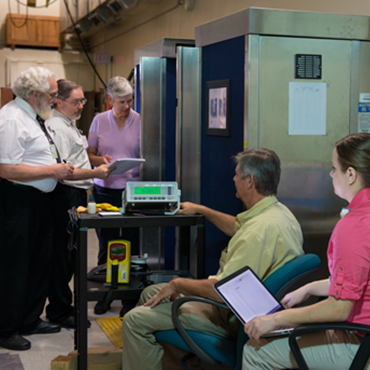NIST, NAS still assessing controversial airport scanners

Privacy concerns forced TSA to scrap its backscatter machines, but radiation levels -- and possible future uses -- are still being studied.

Members of the NAS team and National Academies representatives with the NIST scanner. From left to right: Leslie Braby, Erik Svedberg, Sandra Hyland, David Hintenlang and Sadije Redzovic. (Image/NIST)
Even though the Transportation Security Administration pulled hundreds of backscatter technology security scanners from service a year ago over privacy and radiation concerns, federal research into the controversial machines continues.
National Institute of Standards and Technology (NIST) researchers are currently helping a group of independent researchers from the National Academies of Science (NAS) determine whether radiation exposures produced by backscatter x-ray scanning machines are potentially harmful.
TSA took its nearly 200 backscatter machines out of service in May 2013 after mounting complaints about the revealing X-ray-like images of passengers they produced. Along with privacy concerns, complaints that the machines also exposed people to unacceptable levels of radiation dogged TSA.
The agency switched to scanners that use millimeter-wave technology coupled to advanced imaging technology software that render images of generic human outlines, instead of X-ray like pictures.
When the TSA moved away from the machines two years ago, TSA Administrator John Pistole said the machines might be used in the future if they could be adapted with the software that renders less-graphic images. According to a TSA spokesman, however, the agency has no plans to re-introduce backscatter scanners anytime soon, if at all. It remains committed to its fleet of deployed millimeter wave technology scanners.
"There are no RFPs on FedBizOpps or contracts out there" for backscatter scanners or technologies, the spokesman said -- though he noted TSA is always on the lookout for new technological capabilities that contribute to security and efficiencies. Backscatter technology, properly modified and implemented, might find a way into the mix, 15 or 20 years down the road, but "it's hard to speculate on future technology," he said.
But in a world where portable bombs and other weapons may not have easily-detectable metal parts, the privacy-piercing machines remain capable of producing detailed images that can detect cleverly concealed threats. In a report published online July 21 by NIST, researcher Larry Hudson noted the machines remain in use in private industries that require strict security measures, such as prisons, diamond mines and in the military.
Seeing some potential in the technology, the Department of Homeland Security had asked two years ago for an independent study to focus on the radiation levels produced by the machines. "Original discussions started in 2012 with DHS and the study began at the Academies in 2013," Eric Svedberg, senior program officer of NAS National Material and Manufacturing Board and study director for the group's assessment of the scanner, said in an email to FCW.
NIST hosted NAS research at its Gaithersburg, Md., campus in mid-July, Duncan said. NAS researchers used a lab equipped with a government-surplus backscatter machine, a Rapiscan Secure 1000, that had been used at LaGuardia airport to screen airline passengers before the TSA moved on to AIT and millimeter wave machines.
According to Hudson, NIST had used the same machine for a 2012 report it produced on the scanners' radiation. That study, he said, found the backscatter machines were in compliance with applicable national and international safety standards.
NAS, according to Svedberg, is aiming to complete its research and issue a report by mid-December.
Ultimately, Hudson said, the studies are not meant to pronounce the systems definitively safe or unsafe. The research is meant to inform the debate about radiation with concrete numbers on doses and exposure levels, validate measurement tools and methods, and assess uncertainties.


